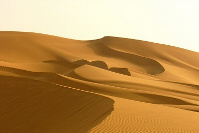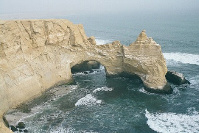 Hot and dry desert
Hot and dry desert
The four major North American deserts of this type are the Chihuahuan, Sonoran, Mojave and Great Basin. Others outside the U.S. include the Southern Asian realm, Neotropical (South and Central America), Ethiopian (Africa) and Australian.
The seasons are generally warm throughout the year and very hot in the summer. The winters usually bring little rainfall.
 Semiarid desert
Semiarid desert
The major deserts of this type include the sagebrush of Utah, Montana
and Great Basin. They also include the Nearctic realm (North America,
Newfoundland, Greenland, Russia, Europe and northern Asia).
 Coastal desert
Coastal desert
These deserts occur in moderately cool to warm areas such as the Nearctic and Neotropical realm. A good example is the Atacama of Chile.
The cool winters of coastal deserts are followed by moderately long, warm summers. The average summer temperature ranges from 13-24° C; winter temperatures are 5° C or below. The maximum annual temperature is about 35° C and the minimum is about -4° C. In Chile, the temperature ranges from -2 to 5° C in July and 21-25° C in January.
 Cold desert
Cold desert
These deserts are characterized by cold winters with snowfall and high
overall rainfall throughout the winter and occasionally over the summer.
They occur in the Antarctic, Greenland and the Nearctic realm. They
have short, moist, and moderately warm summers with fairly long, cold
winters. The mean winter temperature is between -2 to 4° C and the mean
summer temperature is between 21-26° C.
